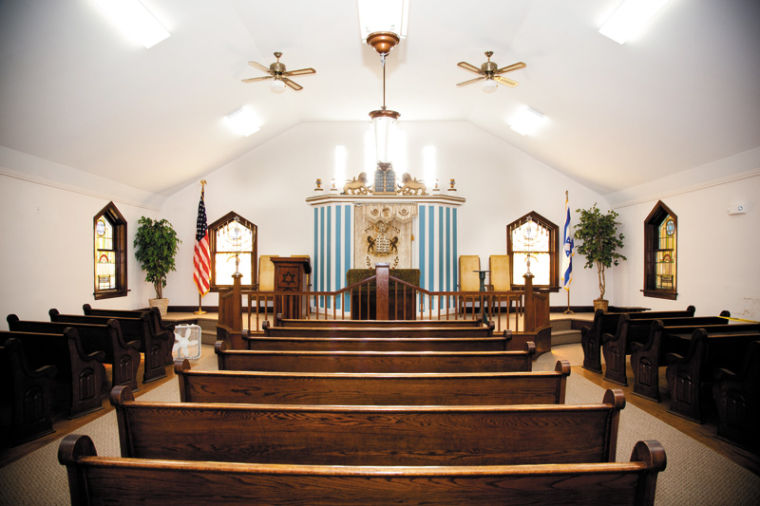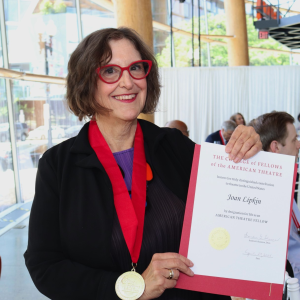Southern Illinois Jewry: scattered, but close-knit
Published September 4, 2013
CARBONDALE, Ill. — Rick Kodner likes to say his mission is helping 1,000 Jews spread out over 40,000 square miles in parts of three states practice their Judaism.
The Jewish communities, from 12 “family units” in Alton to about 60 in Carbondale, may not be as large as they once were. But they continue to honor Judaism and observe life cycle events.
As executive director of the Jewish Federation of Southern Illinois, Southeast Missouri and Western Kentucky, Kodner is concerned that he’s witnessing the slow decline of what were once vibrant, though often small, Jewish communities spread over a vast area from roughly Alton, Ill., at the northern end to Paducah, Ky., at the southern end and much of southeastern Missouri, with Cape Girardeau the largest community.
“We have got a lot of work to do to keep these communities alive,” said Kodner, who’s based in Belleville.
“We are different than St. Louis,” said Gail Lipe, president of Temple Israel in Alton, which meets in a rented former Christian Science reading room. “We are not competing with each other. We are more cohesive. We help each other out…. You are going to find more cohesiveness the farther away you get from St. Louis.”
It’s a measure of members’ commitment to their faith and their communities that they continue, despite some members moving away, no longer attending services and, finally, dying.
“The significance of our communities on this side of the (Mississippi) river is that we exist at all,” Kodner said.
Ruth Rosenberg, 92, who was born in Germany and left a small town in Alsace-Lorraine when she was 15, has lived in Alton 50 years. For many of those years, she owned a women’s clothing store.
A member of Temple Israel in Alton, she is not optimistic about the future of her small congregation.
“Nothing can bring it back,” she said of Temple Israel. “Alton does not have any industry. There is nothing to bring Jewish people here.”
Kodner is busy covering what’s missing in Jewish life in his vast area. Sometimes he officiates at a funeral. Sometimes it’s a baby naming. Sometimes he helps with a bar or bat mitzvah. He was recently in Carbondale, Ill., with Rabbi Mike Rovinsky, a mohel from St. Louis, for a bris.
Kodner even teaches Torah at the Centralia Correctional Center, a medium security prison in Centralia.
According to the late Prof. Walter Ehrlich, who wrote a two-volume set, “Zion in the Valley,” about the history of the Jewish communities of the St. Louis area, the federation where Kodner officially has been director for two years was organized in 1942.
“It was the first successful attempt within American Jewry to organize so many scattered small communities into a federation of Jewish charities,” Ehrlich wrote.
Further, he noted in Volume II, published in 2002, “The area includes between twelve hundred and sixteen hundred Jews, an accurate number being indeterminable because, as the Federation’s executive secretary put it, many are ‘in the woodwork.’”
Keeping the faith alive
No doubt the number of Jews of various degrees of affiliation in Kodner’s federation’s area is slowly declining, but that does not mean they given up. Not by any means.
Some, as Ehrlich alluded to in his book, are scattered all over this vast area, in ones and twos and small groups. If they came out of “the woodwork” to attend services, the count could be somewhat larger.
“If everyone in Carbondale and Murphysboro who is unaffiliated came for Friday night services, we would have to rent a big hall to hold everyone,” said Jack Wides, 67, a retired area businessman who graduated from Murphysboro High School and was the first bar mitzvah in the new Beth Jacob synagogue built in 1959 in Carbondale.
His family founded the congregation, then made up mostly of merchants and their families, in 1945. For 14 years, they met in a tenant farmhouse between Carbondale and Murphysboro until they built the small brick synagogue that holds about 100 congregants in the small sanctuary.
Wides, president of Beth Jacob, has lived in the area all of his life, except for his years at Washington University when he was a member of Zeta Beta Tau fraternity because he “wanted to know some Jewish guys.”
He has two grown children, a son who’s an organic farmer in British Columbia and a daughter in Colorado.
In a recent interview, Wides made a statement few Jews can make: “I have never in any form experienced anti-Semitism.”
This statement of acceptance and tolerance was echoed repeatedly in interviews with community members in and around the small towns of Southern Illinois.
The usual issue of what children should do around Christmas in the public schools has often come up, but the way many counter that is to volunteer to go to the schools to teach non-Jewish children about Hanukkah, Passover and other Jewish holidays.
Parents lived model lives
Several point to the role their parents and grandparents played in establishing their businesses and then the volunteer work they did and continue to do to help the larger communities in which they live.
“Our parents were in business and were professionals,” said Lipe. “Our livelihood depended upon the community where we lived. We were not making waves,”
Wides put the point this way: “The people in Murphysboro had great respect for our parents. They were leaders in the community. They didn’t walk around with mezuzahs hanging out of their shirts. We basked in the glow of our parents’ respect.”
Like many places in the United States years ago, Jews headed to small towns because they saw opportunities to open businesses or establish a medical or other type of professional practice. Today, a similar phenomenon is experienced by Chinese and Indian families who move to small towns and cities to run restaurants and motels and find themselves in the minority.
“The townspeople wanted Jews to come to their town because they knew how to operate stores,” said Kodner. “They knew they were honest businessmen and the people could trust them.”
Several people interviewed referred to “The Jew Store,” a memoir by Stella Suberman about her family’s life in a small southern town she calls Concordia, Tenn.
“The author of ‘The Jew Store’ spoke at a federation meeting,” Wides said. “I said, ‘We don’t have to hear this. We lived it in small town America. Our parents were merchants. The kids went to Washington University and Harvard.’ ”
University provides members
Carbondale is clearly the largest Jewish community in Kodner’s area of responsibility. Today, much of the credit goes to the Southern Illinois University campus.
“This temple has changed from a temple full of merchants, accountants and doctors to university professors and their children,” Wides said.
Sara Faye Marten, head of the Beth Jacob sisterhood, finds that serving on the local interfaith council is an excellent way to build and maintain bridges to the other faith communities in the area.
“The more you know about other religions, the more you realize that we are not that far apart,” Marten said. “This teaches us a lot of respect and honor.”
At the same time, Marten said, tolerance and acceptance are palpable within the congregation, one member to another.
“We are one of the warmest, most welcoming temples you have ever seen,” she said. “And it’s a comfort that we can practice what we believe. No one in the larger community is going to bother me.”
Many of the congregations in the federation’s area are led by laymen and women. That’s even true at Beth Jacob, which has not had a rabbi for at least 10 years, Marten said.
An eclectic, tolerant community
Instead, the congregation is led these days by Sam Goldman, former chancellor of the university who was also professor of education administration and research.
Goldman holds a bachelor of Hebrew letters from the University of Winnepeg in Manitoba, Canada. His master’s and doctorate are from the University of Chicago.
When erev Rosh Hashanah services begin tonight, Goldman, 78, will be on the bimah, leading the congregation. Like Kodner, he roams the territory around Carbondale to officiate at funerals and so on. Sometimes he’s the clergy on call at the local medical center, and he’s looking forward, as always, to High Holy Days.
“We are an eclectic community,” Goldman said. “We have many Jewish people, including converts, plus students… We are such a diverse group, from non-converts (non-Jews who come with their family or friends) to people with a strong family background… We do a lot of Hebrew and we do a lot of English.”
Goldman noted that Beth Jacob in particular and the Jews of theCarbondale-Murphysboro area “very well received as a faith in the community.”
When he is invited to a barbecue, for instance, “they always ask, ‘What will Sam eat?’, ” he said. “I don’t eat pork, so they have something for me.”
Virtually no one in these remote towns keeps kosher.
“It’s too hard,” said Kodner.
But several people contacted for this story, like Susan Pearlman, a retired university professor and Beth Jacob board member and former congregation president, still observe as many of the Jewish dietary laws as they can.
When she goes out, she occasionally has to explain that she doesn’t eat bacon.
“I don’t eat pork or shellfish,” said Pearlman, who grew up in an even smaller town in western Pennsylvania. “I don’t mix meat and milk.”
The sense of Jewish identity is strong, despite the remote, small-town setting. Of Pearlman’s three children, for instance, two sons are living in Israel now. Many children from throughout the area have taken the Birthright Israel trips.
Camp Ben Frankel came up repeatedly in interviews as a most important way to inculcate Jewish values for young people from throughout the area. The camp, with Kodner as director, is located on 3,100 acres near the university.
Now 64 years old, Camp Ben Frankel, Goldman said, “is the signature event of this Jewish community.”
















